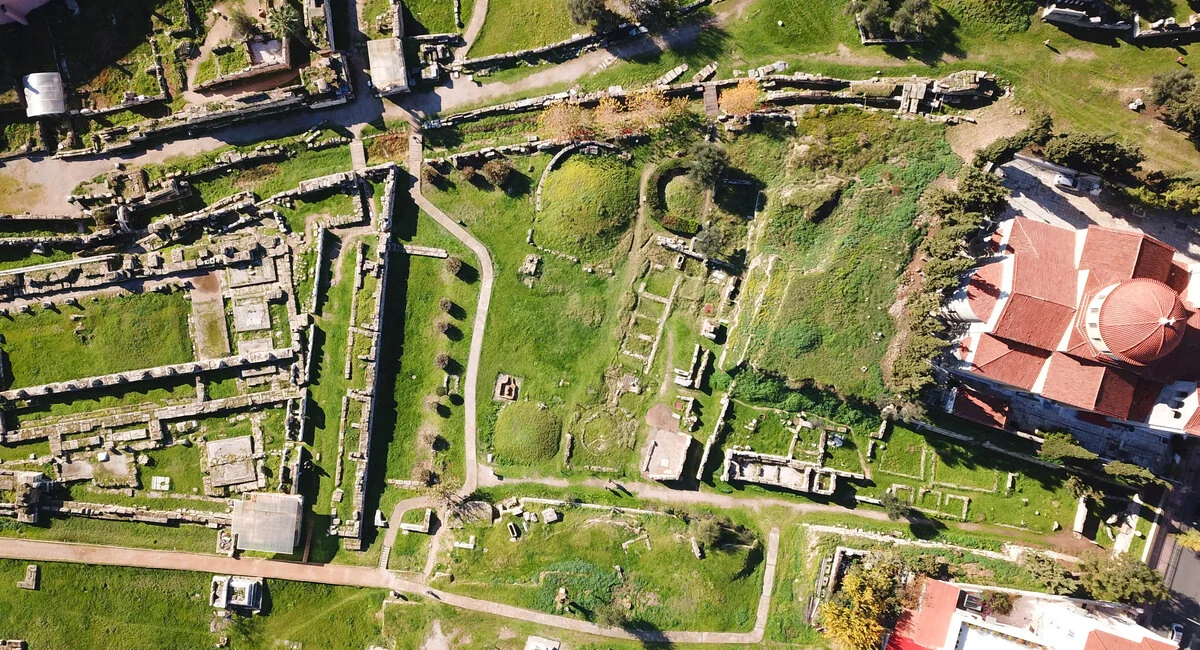The Ancient Greeks were far more demonstrative in their expressions of grief. As a Greek, one would have been appalled with the stiff upper lip British posture. One would have thought it was disrespectful to the dead to show no signs of emotion.
The Ceramicus was the most prestigious burial ground in Athens. (Image: Aerial-motion/Shutterstock)
The Ancient Greeks treated death as a rite of passage to help people negotiate their passage from one state of being to another, in this case from being moribund to being integrated into Hades, the world of the dead. Between these two states of being is a liminal place or condition when someone is neither one thing nor another. The word ‘liminal’ derives from the Latin word limen, meaning ‘a threshold’. As long as one remains on the threshold, one remains in great danger.
To help the dead across the threshold, society constructs rites of passage, which enable the dead to pass from one status to another, ‘from here to there’ as the Greeks put it. These rites facilitate someone’s passage from this world into the next. They’re absolutely critical because if one’s relatives didn’t perform them on one’s behalf, one wouldn’t be able to enter the underworld that the Greeks called Hades.
Death in Ancient Greek Society
“Bury me as quickly as possible,” says Patroclus to this friend Achilles in The Iliad so that he can pass through the gates of Hades. Otherwise, he’ll be left to wander endlessly up and down the banks of the underworld river known as the Styx.
Before continuing with the rites of passage, it is important to consider some of the general observations about death in Greek society. “In the midst of life we are in death,” says the Book of Common Prayer used by the Episcopal Church. Although people know that fact intellectually, they can be forgiven for ignoring it most of the time.
Comparison Between the Modern and the Greek Way of Death
Jessica Mitford in The American Way of Death (1963), an exposé of the abuses perpetrated by the undertaking industry, said that the Americans sublimate death, whereas the British ignore death. The Americans create the fiction that their dead are in a ‘home’ when the truth is that they’re being handled by professionals, whereas the British generally shun all contact with the body except at the funeral. That hits the nail in the coffin squarely on the head.
Both societies fail to confront the existential phenomenon of death head-on. In both societies death generally takes place in a hospital. The very opposite was the case in ancient Greece. As a Greek, one would have faced death head-on, and it deserves great admiration.
The dying—other than those who met their end away from home, including those who met their death on the battlefield—almost invariably had their family members around them. And it was their family, not professional undertakers, who took care of them once they were dead. In fact, the Greek word for a funeral is kêdeia, which literally means ‘caring for’. The word is still used today by the Greek Orthodox Church.
Taking Care of the Dead Body
As a Greek, one would care for the dead bodies of everyone in their family, especially if one were a woman. Given the lower life expectancy in antiquity, if one survived to adult years, it’s almost certainly the case that one would already have experienced the deaths of several family members and also some friends. And since the corpse was prepared for burial in the home, one would have lived, quite literally, cheek by jowl with death.
There were many other ways in which death made itself visible to people in the Greek world. First, since Greek communities were far more closely knit than the modern ones, one would have been much more aware of the death of a neighbor, or an acquaintance, or a distant relative than in modern societies.
Expressing Grief
The Ancient Greeks were far more demonstrative in their expressions of grief, so one would have heard them grieving for hours on end. The Greeks didn’t go in for the famous British stiff upper lip. They believed in letting their hair down, in more ways than one. As a Greek, one would have been appalled with the stiff upper lip British posture. One would have thought it was disrespectful to the dead to show no signs of emotion.
Achilles completely fell apart after the death of Patroclus. (Image: Nikolai Ge/Public domain)
When Achilles in The Iliad learns of the death of his dear friend Patroclus, he completely falls apart—at least by modern standards of subdued grieving. He tears his clothes, beats his breast, rolls about in the dust, and goes without food or drink for several days. He’s a complete basket case. True, he holds himself largely responsible for his friend’s death, but the point is that no Greek would have thought his behavior unmanly. On the contrary, they would have regarded it as entirely appropriate.
Manifestations of grief were regarded as a mark of honor to the dead—they were a way of saying to the dead person that life without them now has no meaning. The dead, one believed, actually took pleasure in witnessing one’s display of grief, irrespective of whether it was completely sincere.
The Monuments of Death: Tombs and the Ceramicus
Another way in which death would make itself felt was by the monuments arranged on either side of all the roads that led out of the city. The most prestigious burial ground in Athens, known as the Ceramicus, which means the Potters’ Quarter, is on the west side of the city just outside a major gate in the surrounding wall. It lies along a public thoroughfare and it probably stretched for several hundred yards.
The Greeks made their last stand at Thermopylae at the famous battle of 480BC. The inscription means ‘Oh stranger, tell the Spartans that we lie here, obedient to their orders’. (Image: Konstantinos Livadas/Shutterstock)
Roads leading out of Athens’ 140-odd demes or townships were also lined with tombs. The funerary monuments that adorned the tombs were the nearest ancient Greek equivalent to the advertising billboards or hoardings that grace major highways today. They sought to arrest the attention of passersby and to impress upon them the prestige and importance of the families that could afford to erect such monuments.
Epigrams Commemorating the Dead
Many of the monuments, in fact, had epigrams commemorating the dead that address the traveler. One of the most famous of these epigrams—by the poet Simonides—marked the communal grave of the 300 Spartans who died fighting the Persians at Thermopylae in 480 B.C.
It reads, “Go tell the Spartans, stranger passing by, that here obedient to their law we lie.” Looking death straight in the eye. So there’s a kind of paradox at work here—unrestrained wailing on the one hand and dignified calm on the other. Both figures invariably exhibit the dignified calm. That’s what Greek tragedy is all about—looking death squarely in the eye.
Common Questions About Death in Ancient Greece
Q: What were the Greek monuments of death?
Tombs and the Ceramicus were the common Greek monuments of death.
Q: What is the Ceramicus?
The Ceramicus was the most prestigious burial ground in Athens. ‘Ceramicus’ means the ‘Potters’ Quarter’.
Q: Why were Greeks more unrestrained in their grief?
Ancient Greeks believed that the dead took pleasure in witnessing one’s display of grief, irrespective of whether it was completely sincere or not.
Q: How did the Greeks honor the dead?
Greeks honored the dead by following the three rites of passage, by building the tombs in the Ceramicus, and by offering the grave goods.
Source: thegreatcoursesdaily











